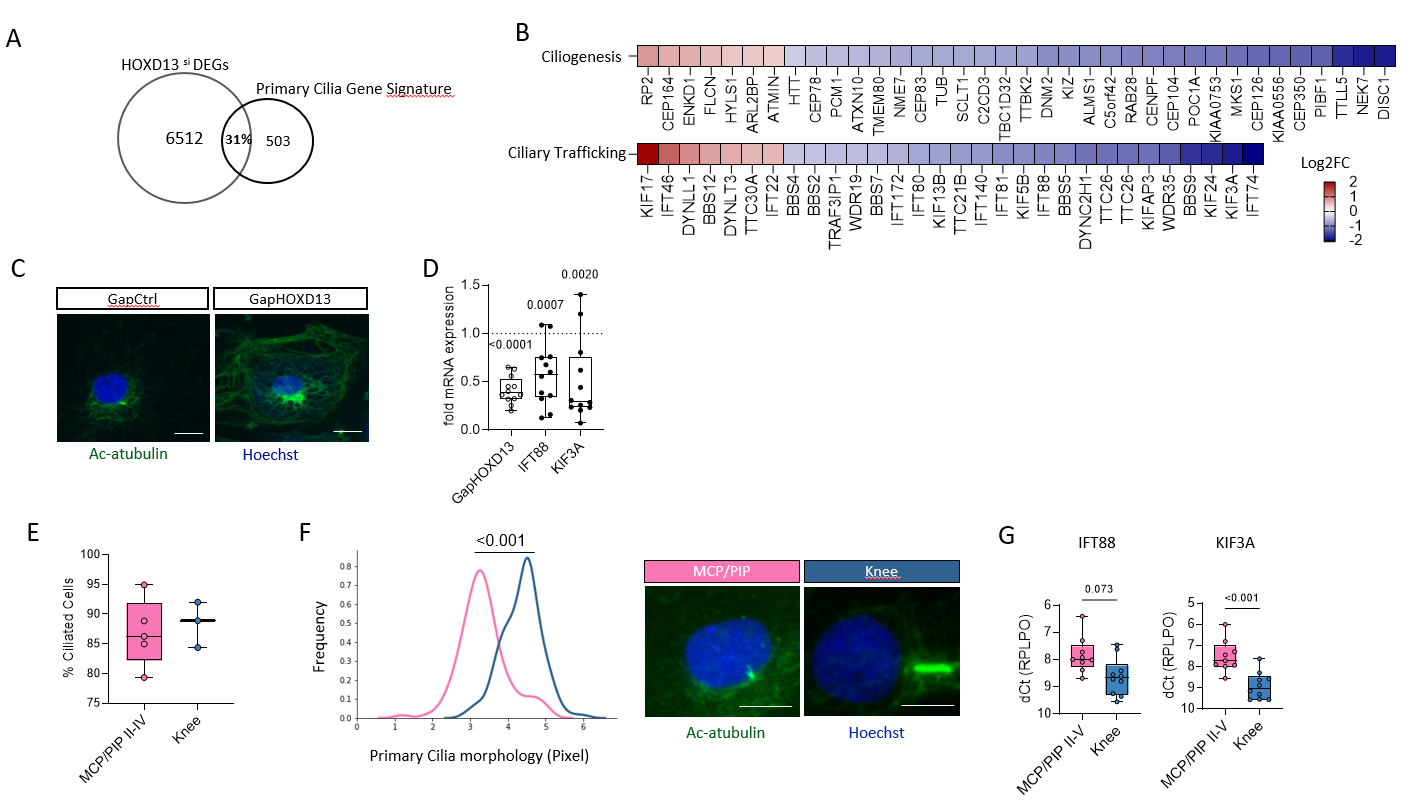Session Information
Session Type: Poster Session B
Session Time: 10:30AM-12:30PM
Background/Purpose: Rheumatoid arthritis (RA) follows a characteristic pattern of joint involvement. The embryonic development of limbs and joints influences certain joints’ propensity to develop arthritis. We previously demonstrated that the Homeobox HOXD13 transcription factor is highly differentially expressed between joint locations and can accurately assign synovial fibroblasts (SFs) to their correct joint location.
Our study aims to decipher the functional differences in SFs from MCP/PIP II-V and knee joints in relation to HOXD13 expression.
Methods: Hand synovial tissues were isolated from RA patients (n=7-12). SFs were cultured and transfected with HOXD13 GapmeR or control GapmeR. RNA was extracted and sequenced on the NovaSeq platform (n=3). qPCR confirmed differentially expressed genes (n=8-12). Primary cilia-associated genes were obtained from UniProtKB using the keyword Cilium (KW-0969). Gene set enrichment analysis and signature expression scores were calculated for HOXD13-silenced hand SFs and bulk RNA sequencing data from unstimulated and TNF-stimulated cells (n=3-5). Primary cilium measurements were performed in serum-starved RA SFs from knee (n=3) and hand (n=5) using immunofluorescence microscopy with acetylated alpha-tubulin. Images were acquired on the CellInsight CX7 platform. A watershed algorithm was used for image segmentation, quantifying primary cilia in 3,000 to 5,000 cells per patient.
Results: Analysis of HOXD13 differentially expressed genes (DEGs) revealed enrichment of terms related to primary cilia assembly and organization (FDR < 0.05, |log2FC| > 20%). HOXD13 targeted about 31% of the ciliary genes (FDR = 0.015, |log2FC| > 20%) (Fig. 1A), mainly downregulating genes involved in ciliogenesis and ciliary trafficking (Fig. 1B). Acetylated alpha-tubulin immunostaining visualized the primary cilium in control cells but showed hyperacetylation of cytoplasmic microtubules in HOXD13-silenced SFs (Fig. 1C). This was followed by downregulation of key ciliary genes (KIF3A, IFT88) after HOXD13 silencing (Fig. 1D).
DEGs between RA SFs from hand and knee showed terms associated with primary cilium (FDR < 0.05, |log2FC| > 20%). There was significant enrichment of the cilium gene signature in MCP-Knee DEGs (FDR = 0.03). Following in vitro TNF stimulation, genes involved in ciliogenesis and ciliary trafficking were dysregulated, especially in hand SFs (FDR < 0.05, |log2FC| > 20%). Serum-starved SFs from different joints consistently had 75%-100% ciliated cells, regardless of origin (Fig. 1E). However, primary cilia were significantly shorter/more upright in serum-starved hand SFs compared to longer/more inclined ones in knee SFs (Fig. 1F). Joint-specific expression patterns of ciliary genes KIF3A and IFT88 were confirmed by qPCR (Fig. 1G).
Conclusion: Our findings suggest HOXD13 plays a pivotal role in ciliary biogenesis in hand SFs and may be responsible for observed ciliary differences between hand and knee SFs. Given the importance of primary cilia in various biological processes, we hypothesize that HOXD13 regulates fibroblast functions through the primary cilium, creating a joint-specific environment that influences the development and progression of RA in specific joints.
To cite this abstract in AMA style:
Mirrahimi M, Klein K, Khmelevskaya A, Camarillo Retamosa E, Houtmen M, Distler O, Ospelt C. HOXD13 Regulation of Primary Cilia in Rheumatoid Arthritis Synovial Fibroblasts: Implications for Joint-Specific Pathogenesis [abstract]. Arthritis Rheumatol. 2024; 76 (suppl 9). https://acrabstracts.org/abstract/hoxd13-regulation-of-primary-cilia-in-rheumatoid-arthritis-synovial-fibroblasts-implications-for-joint-specific-pathogenesis/. Accessed .« Back to ACR Convergence 2024
ACR Meeting Abstracts - https://acrabstracts.org/abstract/hoxd13-regulation-of-primary-cilia-in-rheumatoid-arthritis-synovial-fibroblasts-implications-for-joint-specific-pathogenesis/

